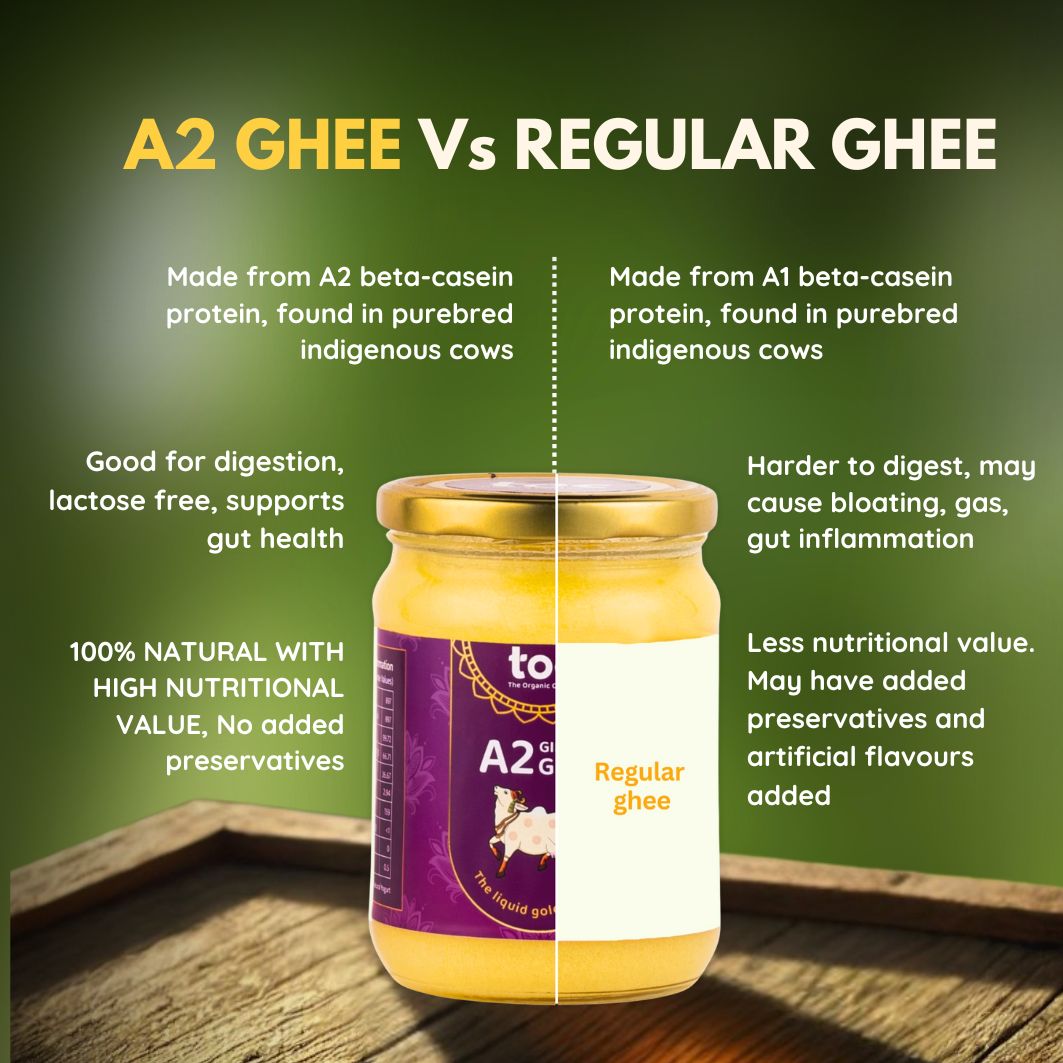Ghee has long been cherished in Indian kitchens for its rich taste and health benefits. However, not all ghee is created equal. While A2 ghee is derived from the milk of indigenous cows and prepared using traditional methods, regular ghee is often mass-produced, with concerns about hormone injections in cows and adulteration during processing. Let’s uncover the major differences and why choosing A2 ghee is a healthier and safer option.
1. The Source: Indigenous vs. Commercial Cows
- A2 Ghee comes from the milk of native Indian cow breeds like Gir, Sahiwal, and Red Sindhi, which naturally produce only A2 beta-casein protein.
- Regular Ghee is often made from the milk of foreign hybrid cows like Holstein and Jersey, which produce A1 beta-casein protein. Studies suggest that A1 protein may be linked to inflammation and digestive issues.
2. The Use of Hormones in Dairy Industry
- Regular dairy farms frequently inject cows with synthetic hormones like Oxytocin and rBGH (Recombinant Bovine Growth Hormone) to increase milk production.
- These hormones can cause severe health issues in cows, including painful swelling of the udder, infections, and stress, ultimately leading to a shorter lifespan.
- When humans consume dairy from hormone-injected cows, these artificial substances may interfere with the endocrine system, leading to hormonal imbalances, early puberty, and other health risks.
- A2 ghee is free from such artificial hormones, as it is sourced from ethically raised indigenous cows that are not subjected to hormone injections.
3. Adulteration in Regular Ghee
To meet high market demands and reduce costs, many brands mix adulterants into regular ghee, compromising its quality. Some common adulterants include:
- Vanaspati (Hydrogenated Oils) – Increases quantity but contains trans fats that are harmful to heart health.
- Starch – Cheap filler that reduces purity and affects digestion.
- Synthetic flavors and colors – Used to mimic real ghee’s aroma and texture but may cause long-term health issues.
- Animal Fats – In some cases, low-quality ghee may contain fats from non-dairy sources, making it impure.
A2 ghee, on the other hand, is traditionally made using the Bilona method, ensuring purity, authenticity, and superior nutritional value.
4. Nutritional Superiority of A2 Ghee
Pure A2 ghee offers numerous health benefits over regular ghee:
- Rich in Omega-3 & Omega-6 fatty acids – Supports heart health and brain function.
- High in Vitamins A, D, E, and K – Boosts immunity, improves bone strength, and enhances skin health.
- Contains Butyric Acid – Aids digestion and promotes gut health.
- Completely free from synthetic additives, preservatives, and harmful chemicals.
5. Ethical & Sustainable Farming Practices
- A2 ghee is produced using traditional and sustainable dairy practices, where cows are allowed to graze freely and are not subjected to factory farming conditions.
- Regular ghee, especially from large-scale dairy farms, often comes from cows that are over-milked, kept in confined spaces, and fed artificial feeds to boost milk production.
Conclusion: Choose Purity, Choose A2 Ghee
While regular ghee may be more affordable and widely available, the use of hormones, adulterants, and low-quality processing methods makes it a questionable choice for long-term health. A2 ghee, made from pure, ethically sourced milk, without any artificial hormones or adulteration, is the superior option.If you are looking for a truly natural and health-boosting ghee, choose A2 ghee – the way ghee was meant to be!






